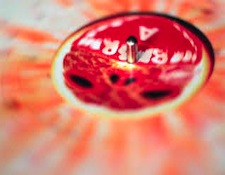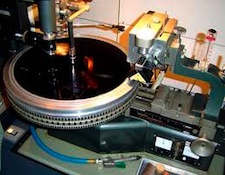It’s the time of year for saving money!

In this time when even the CD is looking like it’s being edged out by downloads, and actually owning a physical recording is starting more and more to seem passé, vinyl ― perhaps the ultimate physical recording ― is increasingly resurgent. Not only is it coming back, but it’s actually popping up in a number of alternative or “enhanced” formats that may or may not offer any real improvement, but are all at least interesting and some of which may even work for you.
One alternative that’s not actually new, but does offer a real possibility of improvement is “half speed mastering.” In practice, this is really simple: To make the “master” recording, an original recording is played at half-speed (7 ½ ips [inches per second] if it was originally recorded on analog tape at 15 ips or 15 ips if it was recorded at 30) into a disc-cutting lathe which is also operating at half-speed (16 2/3 rpm instead of 33 1/3 rpm). Doing this reduces all of the frequencies to be recorded by half ― 20 kHz becomes 10 kHz, 1 kHz becomes 500 Hz, etc. ― and makes the job of the disc cutting head a whole lot easier. Because disc cutting heads, regardless of manufacturer, were limited in high frequency capability, and were typically rolled-off by 3dB or more at 15 kHz, half-speed mastering effectively doubles the high frequency response of the cutting head and allows for a new -3dB point well above 20 kHz, which is all there when the record is played-back at the normal speed of 33 1/3 rpm. Yummy!

Another option which increases available high frequency recording capability (at the cost of less recording time per disc) is cutting an LP at 45 rpm instead of the customary 33 1/3. Doing that increases the number of inches of groove that are cut every second by 35%, which doesn’t help the cutting head’s performance at all, but makes it easier for the playback cartridge to track the higher frequencies (and also explains the lowered maximum recording time). The one possible negative sonic side-effect may be somewhat higher “groove noise” as the stylus drags along 35% more groove for every second of playback. Dust in the groove may also be slightly more noticeable for the same reason, but if the discs are kept clean (and who doesn’t clean their vinyl before every play) it should be no problem.

12 inch 45 rpm versions of their regular LP recordings are available from a number of companies. If your ‘table will play 45s, one recording you might want to check out is the 45 rpm two disc set of the Berlioz Symphonie Fantastique from Reference Recordings (also available as a 33 1/3 rpm single disc). It’s a wonder and a glory both musically and sonically, and well worth having! It also points out another possible advantage of the 45 rpm format: Breaking the very long musical performance into two sections and putting it on two discs instead of one gives the engineer, Keith Johnson, the luxury of having lots of “land” between the groove spirals. This means that wider physical swings of the cutting stylus can be tolerated, which, in turn, means greater possible dynamic range than from conventional fixed or variable pitch microgroove recordings, and the set’s dynamics are ― in keeping with the music ― thrilling, to say the least!
Another vinyl alternative that may or may not be worthwhile to you is the 180 gram disc. Ordinary LPs are standardized at 130 grams of vinyl, so the 180 gram format is a bit more than 38% heavier (although still less than the 200 gram UHQR recordings offered at one time by Mobile Fidelity Sound Labs).

Making discs heavier means, of course, making them thicker: When LPs are all 12 inches in diameter, if they’re all made out of the same stuff, about the only place the extra 50 grams of vinyl CAN go is into making them thicker. That can be an advantage because greater thickness makes them more resistant to both macro and micro warpage, which can affect the sound. It can also be a disadvantage because the extra thickness will change the effective vertical tracking angle (VTA) of your cartridge and even a small amount of VTA error can make your records sounds quite noticeably WORSE. If you are planning to use 180 gram discs, my best suggestions are to either use ONLY 180 gram discs and optimize your arm’s VTA setting just for them; OR buy a tonearm that features easy VTA adjustment and get really good at resetting it every time you change from standard to 180 gram records and back; OR, if you can afford it/them, get a turntable setup with two arms and two cartridges (and two phono cables) and a preamp with two phono inputs; set one arm up for 130 gram standard LPs and set-up the other for 180 gram discs and simply switch back and forth at your preamp. Mmmm, Good! Mmmm, EXPENSIVE. Mmmm.
One little thing; you’ll find that some records claim to be made of virgin vinyl. That just means that the record is made from pure never-been-used-before vinyl, as opposed to a mixture of new and re-cycled vinyl (which is just shredded and melted old records, but MIGHT [but is claimed not to] contain tiny shreds of left-over label from the first time around). It’s POSSIBLE, but by no means certain that the virgin vinyl pressings might have a little less surface noise than the mix, but it’s “iffy”, either way.

Two more things: Some of the vinyl recordings you’ll find will say that they have been “re-mastered.” Does that mean that they are either better or worse than the originals? It could be either. All re-mastering means is that one more person has taken a crack at improving the sound of the original recording. Did he succeed, make it worse, or have no noticeable effect?
There’s no way to know except by listening. Finally, and sort of on the same subject of mastering: Some vinyl discs are now being made from digital original recordings; are they better, worse or the same as the digital versions? Again, it could be anything. If they’re better, though, it’s NOT because they’re on vinyl, but because they were made from a different master than the digital version ― one that’s probably less compressed and equalized.
Got all that? Good. Happy vinyl! Enjoy





